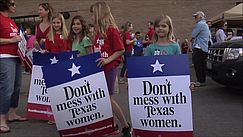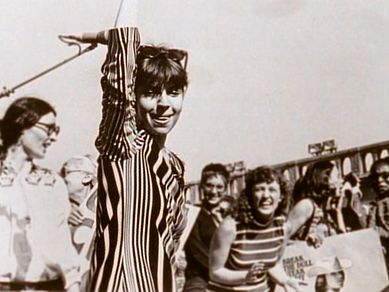Click! in the Classroom
Feminist Activism in the 1960s:
The Personal is Political
Grade Level: Grades 10-12 | Estimated Time: One class period |
Women are human beings — is this a radical idea?
Trailer for “She’s Beautiful When She’s Angry,” a film by Mary Dore. (Running time 2:42) Used with permission. To learn more, visit shesbeautifulwhenshesangry.com. The complete film is available from Cinema Guild.
Introduction
This lesson introduces students to women activists who helped define and broaden the public discussion of women’s issues in the late 1960s, an era of enormous political upheaval in the United States and around the world.
Scholars often divide the women’s movement of the late 1960s and 1970s into two generations. The older generation, known as equal rights feminists, campaigned for equal rights and equal opportunities for women. They founded lasting organizations such as the National Organization for Women (NOW). The younger generation, often called the women’s liberation movement, learned their political lessons in the civil rights and antiwar movements. They wanted to transform both public and private life. A founding event of the women’s liberation movement is the 1968 Miss America Pageant Protest.
Learning Objectives
Students will be able to demonstrate an understanding of women’s 1960s political activism.
Students will be able to define key words, including “sexism” and “gender.”
Students will be able to differentiate between two generations of feminist activists.
Essential Questions
Was the 1960s an era of personal and group liberation for women?
Do men benefit from the oppression of women?
Is success a result of individual initiative or societal structures?
Materials
Technology: Computer with Speakers and Internet Access
This Lesson Plan (PDF)
Primary Document: “The National Organization for Women’s 1966 Statement of Purpose” (PDF)
Primary Document: “No More Miss America! Press Release” (PDF)
Warm Up Activity: Film Viewing and Discussion
Tell the students that they will be learning more about the 1960s women’s movement, emphasizing that this movement is part of the larger histories of post-World War II movements to expand equal opportunity and justice for all Americans. Begin with the two film clips and end with class discussion:
She’s Beautiful When She’s Angry (2:42 min.), also located at the top of this lesson plan.
Miss America (2:49 min.), also located below.
Why did feminists protest against the Miss America pageant in 1968?
Excerpt from “Miss America,” a film by Lisa Ades. (Running time 2:49) Used with permission. The complete film is available from Women Make Movies.
Main Activity: Group Research, Document Analysis, and Discussion
Divide the class into an even number of groups.
Have students go to the Click and tell them to read the essay “The Revival of Feminism” in the Politics & Social Movements chapter to learn about the two generations of the women’s movement.
Have half the class focus on the older women’s rights generation of activists and the other half of the class focus on the younger women’s liberation generation.
Hand out a Document Analysis Worksheet (PDF) to each student.
Direct the group looking at the older women’s rights generation to research and examine the National Organization for Women (NOW).
Hand out copies of the document “National Organization of Women Statement of Purpose, 1966” (PDF) to this group.
Direct the group looking at the younger generation to research and examine the Redstockings.
Hand out copies of “No More Miss America! Press Release” (PDF) to this group.
Have the students complete their readings and their Document Analysis Worksheets.
Bring the groups back together and have the students discuss what they have learned.
The students should refer to their worksheets while they speak.
Tip: It may be helpful to write student oral responses on chart paper to track their whole group participation and keep track of the ideas they generate.
Extension Activity: Film Viewing and Discussion
Have students watch the clip on Rita Arditti from the film A Moment in Her Story (2:28 min.)
Ask the students if Arditti is from the older or younger generation of feminists.
Discuss how she is an example of how the younger generation challenged how we think about women’s place. In this case the place is in science and STEM fields.
Common Core Anchor Standards
Reading
Key Ideas and Details:
CCSS.ELA-LITERACY.CCRA.R.2
Determine central ideas or themes of a text and analyze their development; summarize the key supporting details and ideas.
Craft and Structure:
CCSS.ELA-LITERACY.CCRA.R.6
Assess how point of view or purpose shapes the content and style of a text.
Speaking and Listening
Presentation of Knowledge and Ideas:
CCSS.ELA-LITERACY.CCRA.SL.4
Present information, findings, and supporting evidence such that listeners can follow the line of reasoning and the organization, development, and style are appropriate to task, purpose, and audience.
How to Navigate our Interactive Timeline
You will find unique content in each chapter’s timeline.
Place the cursor over the timeline to scroll up and down within the timeline itself. If you place the cursor anywhere else on the page, you can scroll up and down in the whole page – but the timeline won’t scroll.
To see what’s in the timeline beyond the top or bottom of the window, use the white “dragger” located on the right edge of the timeline. (It looks like a small white disk with an up-arrow and a down-arrow attached to it.) If you click on the dragger, you can move the whole timeline up or down, so you can see more of it. If the dragger won’t move any further, then you’ve reached one end of the timeline.
Click on one of the timeline entries and it will display a short description of the subject. It may also include an image, a video, or a link to more information within our website or on another website.
Our timelines are also available in our Resource Library in non-interactive format.
Timeline Legend
Yellow bars mark entries that appear in every chapter
This icon indicates a book
This icon indicates a film
1971 The Click! Moment
The idea of the “Click! moment” was coined by Jane O’Reilly. “The women in the group looked at her, looked at each other, and ... click! A moment of truth. The shock of recognition. Instant sisterhood... Those clicks are coming faster and faster. They were nearly audible last summer, which was a very angry summer for American women. Not redneck-angry from screaming because we are so frustrated and unfulfilled-angry, but clicking-things-into-place-angry, because we have suddenly and shockingly perceived the basic disorder in what has been believed to be the natural order of things.” Article, “The Housewife's Moment of Truth,” published in the first issue of Ms. Magazine and in New York Magazine. Republished in The Girl I Left Behind, by Jane O'Reilly (Macmillan, 1980). Jane O'Reilly papers, Schlesinger Library.



